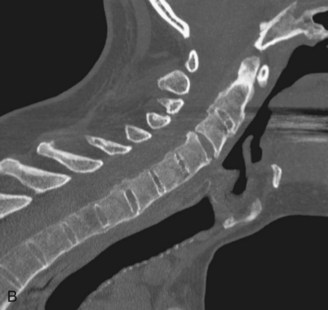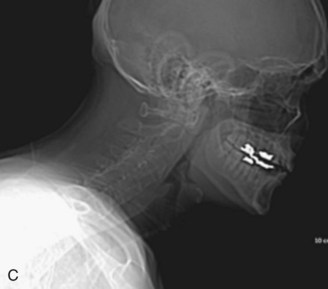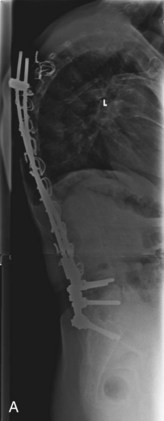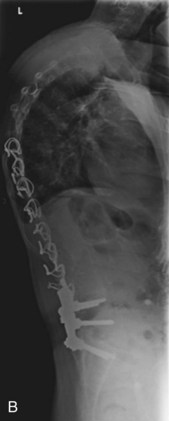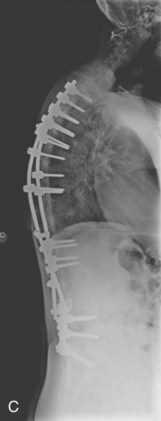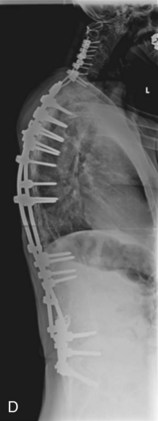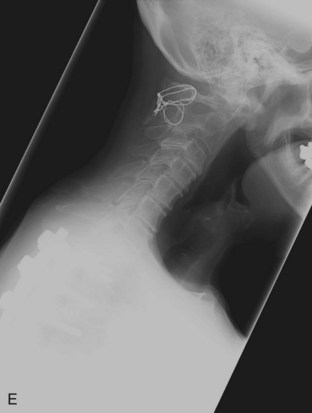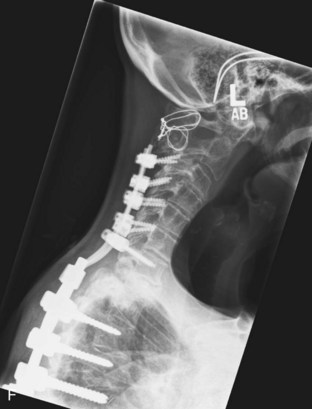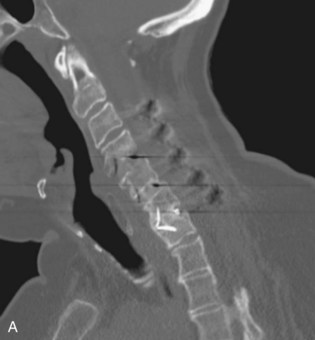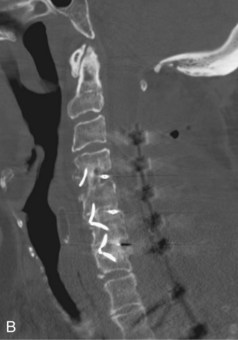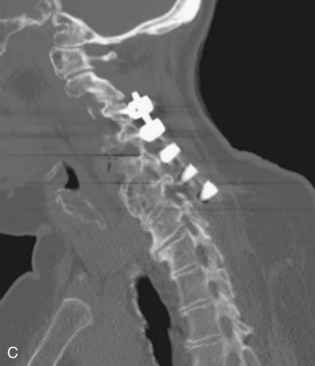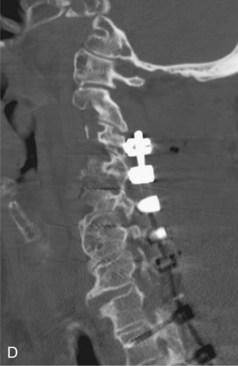Procedure 14 Posterior Cervical Osteotomy Techniques
Indications
Indications Pitfalls
• Anterior neural compression—may require anterior decompression before deformity correction
• Ossification of the posterior longitudinal ligament—may be adherent to or penetrate ventral dura
• Osteoporosis—may require longer fixation construct
• Chronic steroid dependency—may require use of bone morphogenetic protein in addition to local autograft
Treatment Options
• Pedicle subtraction osteotomy (PSO)—single, posterior-only approach, and focal deformity correction
• Combined procedures—posterior only: thoracic osteotomies (Ponte or Smith-Petersen with or without C7 or T1 PSO); combined anteroposterior (AP) deformity correction: one or more anterior cervical diskectomy and fusion combined with posterior thoracic osteotomies (Ponte, Smith-Petersen, PSO)
Procedure Notes
 The cervical-thoracic PSO can be performed following a lumbar PSO in a patient with global spinal kyphosis—C7 plumb line anterior to the L5-S1 disk space—that still displays forward cervical decompensation. Figure 14-1, A is a preoperative lateral radiograph showing cervical-thoracic and thoracic-lumbar kyphosis in this patient with advanced ankylosing spondylitis. Figure 14-1, B shows a preoperative computed tomography (CT) scan in this patient with ankylosing spondylitis having cervical-thoracic kyphosis and forward decompensation. Figure 14-1, C is a lateral radiograph showing cervical-thoracic kyphosis. Figure 14-1, D is a lateral radiograph showing L2 PSO and T1 PSO with achievement of good sagittal balance.
The cervical-thoracic PSO can be performed following a lumbar PSO in a patient with global spinal kyphosis—C7 plumb line anterior to the L5-S1 disk space—that still displays forward cervical decompensation. Figure 14-1, A is a preoperative lateral radiograph showing cervical-thoracic and thoracic-lumbar kyphosis in this patient with advanced ankylosing spondylitis. Figure 14-1, B shows a preoperative computed tomography (CT) scan in this patient with ankylosing spondylitis having cervical-thoracic kyphosis and forward decompensation. Figure 14-1, C is a lateral radiograph showing cervical-thoracic kyphosis. Figure 14-1, D is a lateral radiograph showing L2 PSO and T1 PSO with achievement of good sagittal balance.
 Figure 14-2, A and B show a patient with a history of advanced rheumatoid arthritis and scoliosis with hardware failure after a Luque sublaminar wiring scoliosis correction with bilateral rods removal. The patient developed progressive cervical-thoracic and thoracic kyphosis and underwent an initial revision thoracic-to-sacral posterior spinal fusion (Figure 14-2, C). The cervical-thoracic kyphosis worsened, causing sagittal imbalance and fatigue-related pain. Figure 14-2, D is a full-length scoliosis radiograph showing the sagittal correction following a cervical-thoracic PSO. Figure 14-2, E and F show the preoperative and postoperative PSO, respectively.
Figure 14-2, A and B show a patient with a history of advanced rheumatoid arthritis and scoliosis with hardware failure after a Luque sublaminar wiring scoliosis correction with bilateral rods removal. The patient developed progressive cervical-thoracic and thoracic kyphosis and underwent an initial revision thoracic-to-sacral posterior spinal fusion (Figure 14-2, C). The cervical-thoracic kyphosis worsened, causing sagittal imbalance and fatigue-related pain. Figure 14-2, D is a full-length scoliosis radiograph showing the sagittal correction following a cervical-thoracic PSO. Figure 14-2, E and F show the preoperative and postoperative PSO, respectively.
 A progression of surgical osteotomies can be performed to the extent needed to obtain adequate kyphosis correction, beginning with upper thoracic Ponte osteotomies, one or more Smith-Petersen osteotomies, and cervical-thoracic PSO. Preoperative (Figure 14-3, A) and postoperative (Figure 14-3, B) show midsagittal CT scans following Ponte and Smith-Petersen osteotomies for cervical-thoracic kyphosis correction in an achondroplastic dwarf who developed progressive cervical-thoracic kyphosis after C1-T12 laminectomy for central spinal stenosis (25 years earlier), and after a C3-C7 fusion (2 years earlier). Note that a PSO was not necessary in this patient. Note the preoperative (Figure 14-3, C) versus postoperative (Figure 14-3, D) paraspinal CT scan showing the anterior column lengthening at C7-T1 that occurs following Smith-Petersen osteotomies. This is in contrast to posterior column shortening that occurs following a PSO (see Figure 14-2, F).
A progression of surgical osteotomies can be performed to the extent needed to obtain adequate kyphosis correction, beginning with upper thoracic Ponte osteotomies, one or more Smith-Petersen osteotomies, and cervical-thoracic PSO. Preoperative (Figure 14-3, A) and postoperative (Figure 14-3, B) show midsagittal CT scans following Ponte and Smith-Petersen osteotomies for cervical-thoracic kyphosis correction in an achondroplastic dwarf who developed progressive cervical-thoracic kyphosis after C1-T12 laminectomy for central spinal stenosis (25 years earlier), and after a C3-C7 fusion (2 years earlier). Note that a PSO was not necessary in this patient. Note the preoperative (Figure 14-3, C) versus postoperative (Figure 14-3, D) paraspinal CT scan showing the anterior column lengthening at C7-T1 that occurs following Smith-Petersen osteotomies. This is in contrast to posterior column shortening that occurs following a PSO (see Figure 14-2, F).
Examination/Imaging
 Full-length standing scoliosis radiographs: AP and lateral radiographs with hips and knees in full extension
Full-length standing scoliosis radiographs: AP and lateral radiographs with hips and knees in full extension




